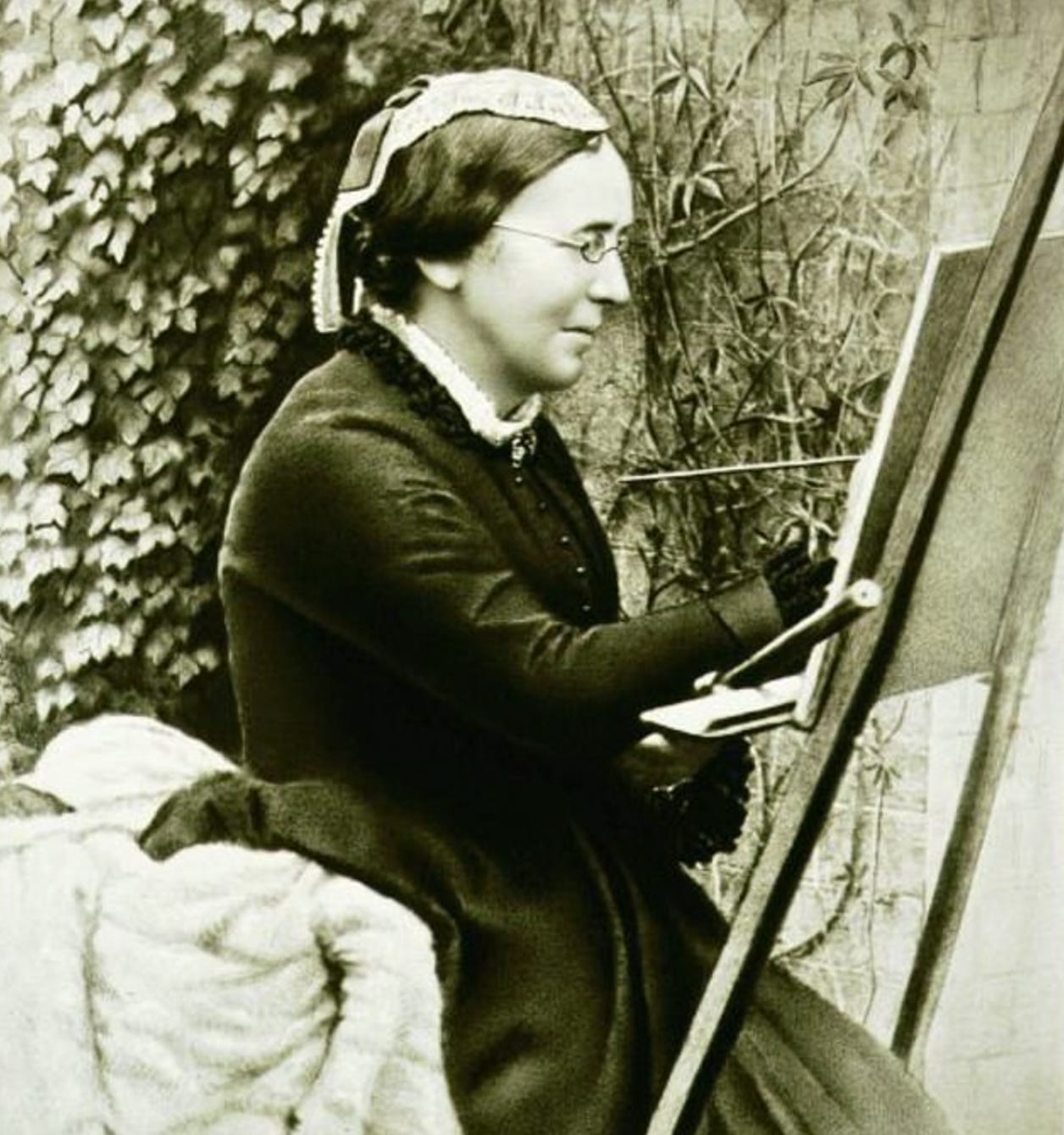Welcome aboard The Bus!
The Stop
Marianne North (1830-1890) was an English naturalist and painter who flouted social and artistic conventions to become one of the 19th century’s most famous botanical artists. Despite the Victorian attitude against women travelling alone without a husband or male chaperone, between 1871 and 1885, she travelled extensively – and almost always alone. During these years, she visited 15 countries and painted the people, places and plants she saw. The result was a remarkable, accurate collection of artworks and writings which opened Europeans to a world of knowledge about the ‘location, habitat and uses’ of many previously unknown plants.1
Born in Hastings, Marianne had a close relationship with both of her parents. She originally trained as a vocalist, but when her voice failed, she turned her attention to painting flowers when the family relocated to Continental Europe. When she was 25 her mother died, and she began to travel constantly with her father whose job as a Member of Parliament took them on multiple trips around Europe and the Middle East. She had a close relationship with her father and was ‘devastated’ when he died in 1869. Forty years old and unmarried, Marianne rebelled against the Victorian belief that the lives of middle- and upper-class women should revolve around the home, their husbands, and children. Turning her back on this convention for the rest of her life, she embarked on a ‘series of solo trips to some of the wildest places on Earth’ to fulfil her ambition of painting the flora of exotic countries.
In 1871-1872, she travelled to Canada, the United States and Jamaica, before spending a year in Brazil, where she completed most of her work at a ‘hut in the depths of a forest.’ Following a few months in Tenerife, in 1875 she began a journey across the world, and for the next two years painted the flora of California, Japan, Borneo, and Ceylon.2 She spent 1878 in India, and upon returning to England offered her collection of specimen paintings – to be housed in a gallery she funded – to the botanical gardens at Kew.3
A conversation with Charles Darwin led to a year of painting in Australia and New Zealand in 1880, and she then travelled to South Africa in 1882-1883. In 1884-1885 she undertook her last journey, this time to Chile where she travelled for the specific purpose of painting the monkey puzzle tree. Described as possessing a ‘singular charm and quiet dignity,’ she was entirely focussed on painting and ‘paid scant attention to the people or the politics of the regions she visited.’ While travelling, she collected and discovered plants that were unknown to botanical science at the time, including six new species - one of which was the pitcher plant, Nepenthes northeana, in Borneo.
Marianne North’s paintings – composed years before colour photography – were a ‘vibrant snapshot’ of distant lands most Europeans at the time had never seen. She was keen to inspire and educate people about the natural world, and considered her gallery the perfect place to experience these exotic locales. In addition to having several species of plants named after her, the scientific accuracy of her paintings of plants from all over the world ensure her work has a ‘permanent value.’
For a tour of her gallery at Kew Gardens, see: Marianne North Gallery (YouTube).
The Detour
Today’s Detour is to Multiverse, an amazing video (3:26) by Japanese filmmaker Hiroshi Kondo in which (according to Dutch animator/artist Wim Goossens) he ‘transforms the scooter stampedes of Taipei into a hypnotic exploration of the fluid energy and hidden patterns of modern life in Taiwan.’ In the director’s words: ‘A crowd moving in one direction. People who flow in a moment. A scene where the difference with other people disappears and looks uniform. There are many different kinds of life there. You can feel invisible energy when you see a large mass of individuals. I set myself in the streets of Taiwan, and I multilayered a lot of time to create a new timeline that reflects individuals.’ Definitely worth the time.
The Recommendation
Today’s Recommendation is Jane Campion’s The Piano (1993). Starring Holly Hunter, Harvey Keitel, Sam Neill and Anna Paquin, the film is the story of a selectively mute Scottish woman who, in the mid-1800s, travels to New Zealand with her young daughter as part of an arranged marriage to a frontiersman. Released to critical and popular acclaim, the film is a powerful, sensual story of love and sacrifice, and won three Academy Awards: Best Actress for Hunter, Best Supporting Actress for Paquin,4 and Best Original Screenplay for Campion.
The Piano streams on various platforms.
The Sounds
Today’s playlist is composed of five tracks by artists who will be appearing in this year’s summer concert series at Kew Gardens:5 ‘Pompeii’ (Bastille, 2013), ‘Married in Vegas’ (The Vamps, 2020), ‘Youth and Love’ (Jack Savoretti, 2019), ‘Mirror Man’ (The Human League, 1981) and ‘I’m in the Mood for Love’ (Jools Holland and Jamiroquai, 2000). Enjoy!
The Thought
Today’s Thought is from Marianne North. Despite her world travels, she always loved returning to England - and this quote sums her appreciation of its natural offerings:6
‘No life is so charming as a country one in England, and no flowers are sweeter or more lovely than the primroses, cowslips, bluebells, and violets that grow in abundance all around me here.’
If you have a thought on this Thought - or any part of today’s issue - please leave a comment below:
And that’s the end of this Stop - I hope you enjoyed the diversion!
Thanks to everyone who subscribes - your interest and support is truly appreciated. If you like The Bus, please SHARE it with a friend or two.
If you haven’t climbed aboard The Bus, please do!
If you like The Bus, why not check out other newsletters?
The Sample sends out articles from blogs and newsletters across the web that match your interests. If you like one, you can subscribe with one click.
Refind picks five links from around the web that make you smarter, tailored to your interests. Refind is a must-read newsletter loved by over 200,000 curious minds. There’s also a very cool app. Sign up for free!
Until the next Stop …
Marianne North is a remarkable historical figure of whom I think more people should be aware. A visit to Kew Gardens (a must if you’re ever in London for a few days and are tired of the ‘standard’ tourist sites) is incomplete without visiting her gallery. Sources for today’s Stop include Marianne North (S2A3), Marianne North (Kew) and Marianne North (Encyclopaedia Britannica, 1911).
Modern-day Sri Lanka.
The gallery opened in 1882 and was expanded in 1883. It houses over 800 of her original paintings.
Paquin, at 11, was the second-youngest actor to win an Oscar in a competitive category. The youngest winner is Tatum O’Neal for Paper Moon (1973).
‘Kew the Music’ (yes, I know - bad pun) runs from 11-16 July this year and actually has six headliners. Despite not being a fan of Jack Savoretti and being agnostic about Jules Holland (though he’s great live), I chose to include both of them over Haçienda Classiçal - purely because there’s no need to spell either word with a cedilla.
Having now fully entered Spring and living a minute’s walk from a stunning bluebell wood, I completely understand her sentiment. I’ve always enjoyed Spring - but an English one is unlike any other.






Nice one, Bryan! Marianne North is new to me as well. Stark contract between her world and that of Hiroshi's on Taiwan!
Terrific post, Bryan! I've had the pleasure of visiting the Marianne North Gallery at Kew a couple of times, and seeing wall-to-wall art from skirting board right up to the cornices is absolutely and wonderfully overwhelming. Plants, climate and culture given equal billing in pretty much every picture: the intrepid Marianne had such an eye and such a great feel for the places she travelled to and the beauty within them. I love the sheer solidity of her work - the intensity and depth of colour are phenomenal.
Thank you so much for my favourite read of the day.